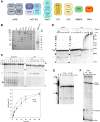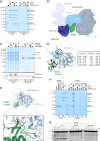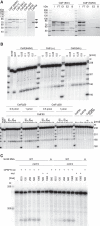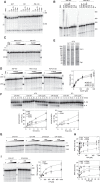Reconstitution of 3' end processing of mammalian pre-mRNA reveals a central role of RBBP6
- PMID: 35177537
- PMCID: PMC8887130
- DOI: 10.1101/gad.349217.121
Reconstitution of 3' end processing of mammalian pre-mRNA reveals a central role of RBBP6
Abstract
The 3' ends of almost all eukaryotic mRNAs are generated in an essential two-step processing reaction: endonucleolytic cleavage of an extended precursor followed by the addition of a poly(A) tail. By reconstituting the reaction from overproduced and purified proteins, we provide a minimal list of 14 polypeptides that are essential and two that are stimulatory for RNA processing. In a reaction depending on the polyadenylation signal AAUAAA, the reconstituted system cleaves pre-mRNA at a single preferred site corresponding to the one used in vivo. Among the proteins, cleavage factor I stimulates cleavage but is not essential, consistent with its prominent role in alternative polyadenylation. RBBP6 is required, with structural data showing it to contact and presumably activate the endonuclease CPSF73 through its DWNN domain. The C-terminal domain of RNA polymerase II is dispensable. ATP, but not its hydrolysis, supports RNA cleavage by binding to the hClp1 subunit of cleavage factor II with submicromolar affinity.
Keywords: 3′ processing; CPSF; RBBP6; RNA cleavage; RNA processing; poly(A) polymerase; polyadenylation.
© 2022 Schmidt et al.; Published by Cold Spring Harbor Laboratory Press.
Figures







Similar articles
-
RBBP6 activates the pre-mRNA 3' end processing machinery in humans.Genes Dev. 2022 Feb 1;36(3-4):210-224. doi: 10.1101/gad.349223.121. Epub 2022 Feb 17. Genes Dev. 2022. PMID: 35177536 Free PMC article.
-
Recent molecular insights into canonical pre-mRNA 3'-end processing.Transcription. 2020 Apr;11(2):83-96. doi: 10.1080/21541264.2020.1777047. Epub 2020 Jun 11. Transcription. 2020. PMID: 32522085 Free PMC article. Review.
-
A complex containing the CPSF73 endonuclease and other polyadenylation factors associates with U7 snRNP and is recruited to histone pre-mRNA for 3'-end processing.Mol Cell Biol. 2013 Jan;33(1):28-37. doi: 10.1128/MCB.00653-12. Epub 2012 Oct 15. Mol Cell Biol. 2013. PMID: 23071092 Free PMC article.
-
Fip1 is a multivalent interaction scaffold for processing factors in human mRNA 3' end biogenesis.Elife. 2022 Sep 8;11:e80332. doi: 10.7554/eLife.80332. Elife. 2022. PMID: 36073787 Free PMC article.
-
3'-End Processing of Eukaryotic mRNA: Machinery, Regulation, and Impact on Gene Expression.Annu Rev Biochem. 2023 Jun 20;92:199-225. doi: 10.1146/annurev-biochem-052521-012445. Epub 2023 Mar 31. Annu Rev Biochem. 2023. PMID: 37001138 Free PMC article. Review.
Cited by
-
Human pre-mRNA 3' end processing: reconstituting is believing.Genes Dev. 2022 Feb 1;36(3-4):106-107. doi: 10.1101/gad.349453.122. Genes Dev. 2022. PMID: 35193945 Free PMC article. Review.
-
Mpe1 senses the binding of pre-mRNA and controls 3' end processing by CPF.Mol Cell. 2022 Jul 7;82(13):2490-2504.e12. doi: 10.1016/j.molcel.2022.04.021. Epub 2022 May 17. Mol Cell. 2022. PMID: 35584695 Free PMC article.
-
A twin UGUA motif directs the balance between gene isoforms through CFIm and the mTORC1 signaling pathway.Elife. 2023 Sep 4;12:e85036. doi: 10.7554/eLife.85036. Elife. 2023. PMID: 37665675 Free PMC article.
-
RBBP6 maintains glioblastoma stem cells through CPSF3-dependent alternative polyadenylation.Cell Discov. 2024 Mar 19;10(1):32. doi: 10.1038/s41421-024-00654-3. Cell Discov. 2024. PMID: 38503731 Free PMC article.
-
Human promoter directionality is determined by transcriptional initiation and the opposing activities of INTS11 and CDK9.Elife. 2024 Jul 8;13:RP92764. doi: 10.7554/eLife.92764. Elife. 2024. PMID: 38976490 Free PMC article.
References
Publication types
MeSH terms
Substances
LinkOut - more resources
Full Text Sources
Other Literature Sources
